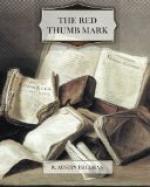While he was speaking he had been fitting the little cylinder between two pads of tissue-paper in the vice, which he now screwed up tight. Then, with the fine metal saw, he began to cut the projectile, lengthwise, into two slightly unequal parts. This operation took some time, especially since he was careful not to cut the loose body inside, but at length the section was completed and the interior of the cylinder exposed, when he released it from the vice and held it up before me with an expression of triumph.
“Now, what do you make it?” he demanded.
I took the object in my fingers and looked at it closely, but was at first more puzzled than before. The loose body I now saw to be a cylinder of lead about half an inch long, accurately fitting the inside of the cylinder but capable of slipping freely backwards and forwards. The steel point which I had noticed in the hole at the apex of the conical end, was now seen to be the pointed termination of a slender steel rod which projected fully an inch into the cavity of the cylinder, and the conical end itself was a solid mass of lead.
“Well?” queried Thorndyke, seeing that I was still silent.
“You tell me it is not an explosive bullet,” I replied, “otherwise I should have been confirmed in that opinion. I should have said that the percussion cap was carried by this lead plunger and struck on the end of that steel rod when the flight of the bullet was suddenly arrested.”
“Very good indeed,” said Thorndyke. “You are right so far that this is, in fact, the mechanism of a percussion shell.
“But look at this. You see this little rod was driven inside the bullet when the latter struck the wall. Let us replace it in its original position.”
He laid the end of a small flat file against the end of the rod and pressed it firmly, when the rod slid through the hole until it projected an inch beyond the apex of the cone. Then he handed the projectile back to me.
A single glance at the point of the steel rod made the whole thing clear, and I gave a whistle of consternation; for the “rod” was a fine tube with a sharply pointed end.
“The infernal scoundrel!” I exclaimed; “it is a hypodermic needle.”
“Yes. A veterinary hypodermic, of extra large bore. Now you see the subtlety and ingenuity of the whole thing. If he had had a reasonable chance he would certainly have succeeded.”
“You speak quite regretfully,” I said, laughing again at the oddity of his attitude towards the assassin.
“Not at all,” he replied. “I have the character of a single-handed player, but even the most self-reliant man can hardly make a post-mortem on himself. I am merely appreciating an admirable piece of mechanical design most efficiently carried out. Observe the completeness of the thing, and the way in which all the necessities of the case are foreseen and met. This projectile was discharged from a powerful air-gun—the walking-stick form—provided with a force-pump and key. The barrel of that gun was rifled.”




